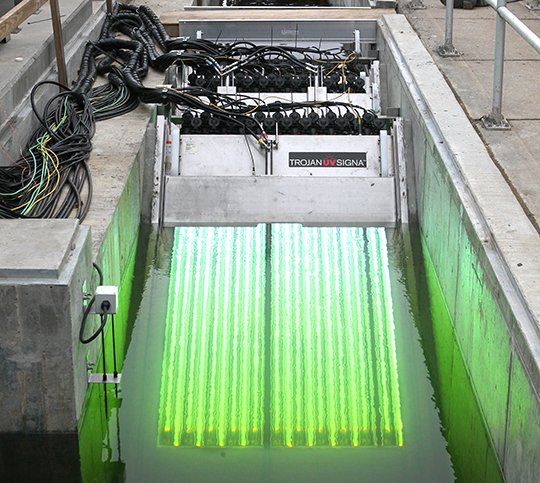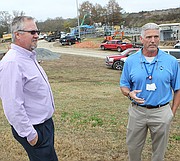Chlorine disinfection at the Regional Wastewater Treatment Plant is no more as of earlier this month.
Formerly the final step in transforming wastewater into effluent that empties into Lake Catherine, chemical disinfection has been supplanted by ultraviolet lamps at the Davidson Drive location. One of two UV channels that’s part of a $9 million plant upgrade went on line last week.
They will be used alternately once both are operational, Hot Springs Utilities Director Monty Ledbetter said. Both can be opened on heavy flow days, when as much as 24 million gallons passes through the plant. Ledbetter said 11 million gallons are treated on an average day.
The plant can treat up to 42 million gallons a day. Flow can also be diverted to the 54 million-gallon equalization basin, where it can be held until the plant is ready to process it.
Conspicuous by the emerald glow they emit, the submerged UV lamps are safer and more environmentally friendly than chemical disinfection, said Ray Ome, who is managing the construction project for RJN Group, the city’s wastewater system consultant.
They eliminate the risk of a chlorine gas release and don’t impart a chemical residue that can have adverse implications downstream, where other utilities use the same receiving waters as their raw-water source.
“Chlorine kills the bacteria,” Ome said. “There’s the potential of chlorine byproduct being left in the receiving waters. With UV, as (flow) passes through, it disrupts the DNA of the bacteria. It’s much better for the receiving waters.”
Ledbetter said meeting the requirements of the city’s National Pollutant Discharge Elimination System permit while putting less strain on the environment is of particular concern to him. He lives in Malvern. The intake for its water utility is below Remmel Dam.
“We have to be good stewards, because I live downstream of this plant,” he said, noting that no fecal or coliform counts have been detected in samples tested at the plant’s lab since the UV system has been in place. “My drinking water comes from the Ouachita River.”
The newer Southwest Wastewater Treatment Plant on Winkler Road already uses UV lamps, but Larry Merriman, major capital projects manager for the city, said the UV array at the Regional Plant is state of the art.
“The system now is better than when we put UV in (at the Southwest plant),” he said. “At that time, it was believed the technology worked best when the bulbs were in a horizontal position as water passes by. These are on a 45-degree angle, which gives it more contact time.”
New headworks and a grit-separation chamber are also part of the upgrade, increasing the plant’s capacity to capture non-degradable solids and smaller particles such as sand that can damage pumps and other equipment farther downstream in the treatment process.
The plant improvements dovetail with the work the city’s doing on the wastewater collection system as part of a $70 million effort to meet the federal mandate it’s been under since 2008. According to the Consent Administrative Order it entered into with the state Department of Environmental Quality, which enforces the Clean Water Act for the Environmental Protection Agency, the city agreed to pay a $105,000 civil penalty in 2011 for 359 wet-weather overflows from January 2004 to May 2008.
The city has said it expects to be released from the CAO soon, perhaps as early as next year. Bonds secured by rates paid by the system’s more than 26,000 wastewater accounts are funding the overhaul, which includes the $113,081 contract the Hot Springs Board of Directors awarded last week to Brown Engineers LLC.
The Little Rock company has been chosen as the city’s sole-source provider for projects related to the utility department’s supervisory control and data acquisition system. The contract awarded earlier this week will connect control equipment for the plant’s new components to the city’s SCADA system.
Ledbetter said stormwater that percolates into the collection system during significant rain events disrupts the treatment process, flushing out microorganisms that consume sewage. Replacing and rehabbing wastewater lines will keep more stormwater out of the collection system and lower the volume that arrives at the plant.
“We inject air to make it aerobic, to where bacteria has food and plenty of oxygen,” Ledbetter said. “That helps break things down a lot faster. On an average day, you have plenty of food coming in to feed the bacteria.
“When we have big rain events and have to take the plant up to 24 (million gallons a day), there’s not as much food sometimes. If that’s a prolonged period, we can actually lose a lot of our bacteria that’s actively working for us.”
Sludge, or biosolids, the treatment process separates from the flow ends up at the city’s compost facility. Before it gets there, it’s heated in an underground digester that divests organic material then squeeze dried through a conveyor belt press.
The finished product is trucked the short distance to the compost facility, where free compost is available to the public, instead of to a landfill that would charge the city costly tipping fees.

